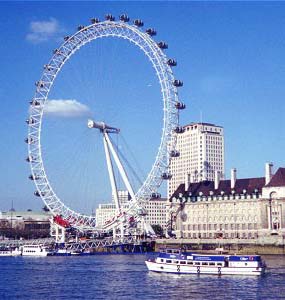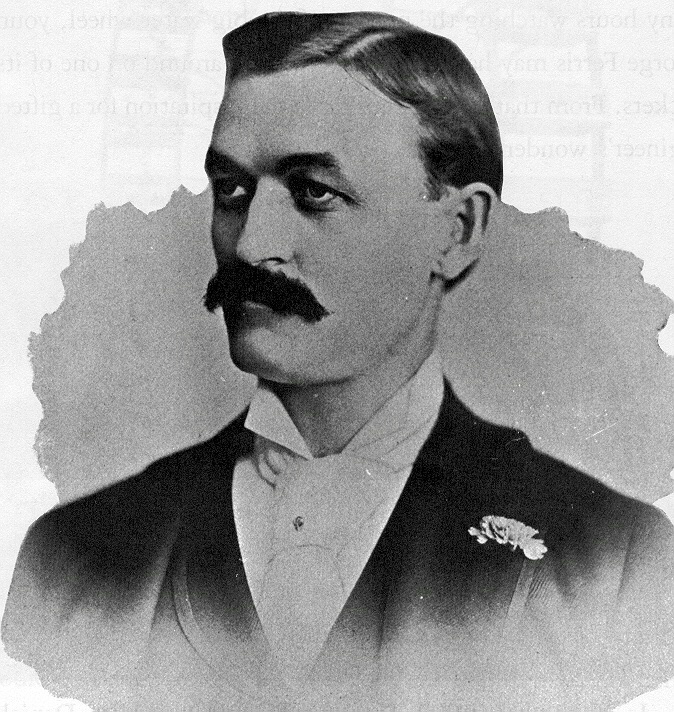- The first ferris wheel was made by a man named George Washington Gale Ferris. Other turning wheels that carried people were built before Ferris's, but his is recognized as the first official ferris wheel.
- Ferris was a civil engineer. Before he made his wheel, he worked in the railroad industry and then became a bridge builder. He got to know a lot about steel, so much that he founded G.W.G. Ferris & Co., a company which tested steel used in bridges and railroads.
- In preparation for the 1893 Chicago Columbian Exposition, which was to be held in honor of the 400th anniversary of Columbus' arrival in America, a bunch of engineers got together in 1891 to plan what marvels they might put together. The goal was to build something that would rival the Eiffel Tower.
- Ferris was in the audience at this discussion. While he listened to what people said, he got an inspiration and drew a picture of it on his napkin. It was essentially an enormous bicycle wheel that people could ride.
- The wheel was 825 feet in circumference and 250 feet across. It was supported by two 140-foot steel towers, which were connected by a 45-foot axle. The wheel had 36 wooden cars, and it was powered by two 1,000 horsepower engines. All of these dimensions were considered remarkable and impressive for the time. Many ferris wheels in use today do not approach these dimensions.
- To build this marvel, Ferris needed $355,000, which he managed to raise. The components were made in Detroit and shipped to Chicago by train on 150 railroad cars. The centerpiece alone weighed 45 tons. Altogether, the whole thing weighed 220 tons. Because of the sheer size and weight, the builders dug eight holes 35 feet deep and 20 square feet across.
- Fully constructed and operational, the ride cost 50 cents. This was in 1893, when the average daily wage of someone who worked for the Pullman railroad company was $1.03. So basically, a lot of people were paying half a day's salary to ride the Ferris wheel. The ride made over $725,000.
- However, almost immediately, other people started to make their own ferris wheels, and theirs were bigger, or taller, or carried more passengers. One guy's, Busset's, has cars specifically for first class passengers and other cars for smoking passengers.
- Most crucially, Ferris's wheel was very difficult to disassemble and set up again elsewhere. Other builders managed to make theirs more portable.
- After the World's Fair, Ferris's wheel was dismantled and was going to be used when the Columbian Exposition moved to New York City, but it would have cost another $150,000 to ship and rebuild the wheel. The wheel was eventually set up again, but it stayed in Chicago, on North Clark Street. Unfortunately, not enough people rode it and it lost money.
- By 1900, Ferris was so deep in debt, he took offers for his wheel and sold it for $1,800. Finally, it was re-erected for the Louisiana Purchase Exhibition, but it again failed to raise enough money to pay for itself. In 1906, the original ferris wheel was sold for scrap iron.

This ferris wheel in Vienna has been in operation for over 100 years.
(Photo by Paula Funnell on flickr)
- However, the concept of the ferris wheel was a hit. More than one hundred years later, any fair worth its cotton candy will have a ferris wheel.
- Today, the ferris wheel at Chicago's Navy Pier is 10 feet higher than the original, has 4 more cars, but is 110 feet smaller in diameter. As of 1999, the world's largest ferris wheel is in London, checking in at 443 feet tall.

The London Eye, from the top of which riders can see for 25 miles
(photo from the World Guide to London)
Sources
About.com, Inventors, Circus and Theme Park Innovations
Columbia Encyclopedia, Ferris wheel
Christine Petone and Mary Lynch, "The Ferris Wheel"
River North Hotel, Chicago's Navy Pier
Nicole Huffman, American Studies Program, University of Virginia, Pullman Strikes Out, Wages and Rents


I once rode a ferris wheel in Japan, which was mounted on top of an already quite tall building. VERY scary experience, but of course thrilling.
ReplyDeletehttp://www.tourism.city.osaka.jp/en/area_osaka/kita/attraction/hep/
We just are finishing reading Erik Larson's book, The Devil in the White City, about the 1893 Chicago Exposition. It's a page turner, and juxtaposes the true story of a serial killer who, under cover of the event, committed dastardly acts. If the Ferris wheel captivates you, there is much about the entire event that would hold your attention even further. Give it a read. It will leave as indelible an impression as the view of the event this far from it.
ReplyDeleteI've heard good things about that book. I haven't read it, but it's probably something I'll pick up at some point. Thanks for the suggestion.
ReplyDeleteHere's a link: The Devil in the White City: Murder, Magic, and Madness at the Fair that Changed America